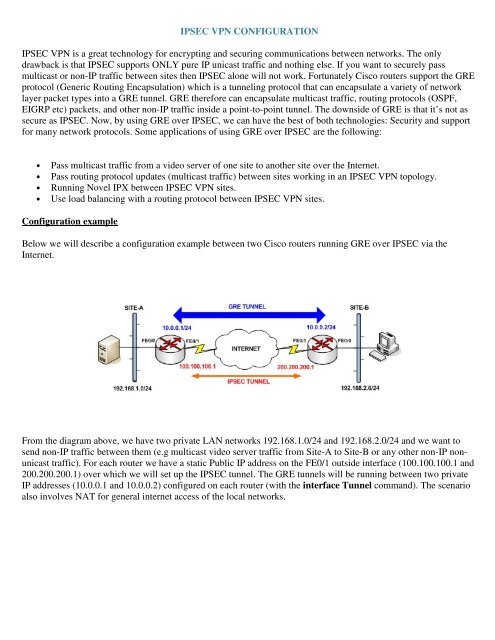IPSEC VPN.pdf - The Cisco Learning Network
IPSEC VPN.pdf - The Cisco Learning Network
IPSEC VPN.pdf - The Cisco Learning Network
You also want an ePaper? Increase the reach of your titles
YUMPU automatically turns print PDFs into web optimized ePapers that Google loves.
<strong>IPSEC</strong> <strong>VPN</strong> CONFIGURATION<br />
<strong>IPSEC</strong> <strong>VPN</strong> is a great technology for encrypting and securing communications between networks. <strong>The</strong> only<br />
drawback is that <strong>IPSEC</strong> supports ONLY pure IP unicast traffic and nothing else. If you want to securely pass<br />
multicast or non-IP traffic between sites then <strong>IPSEC</strong> alone will not work. Fortunately <strong>Cisco</strong> routers support the GRE<br />
protocol (Generic Routing Encapsulation) which is a tunneling protocol that can encapsulate a variety of network<br />
layer packet types into a GRE tunnel. GRE therefore can encapsulate multicast traffic, routing protocols (OSPF,<br />
EIGRP etc) packets, and other non-IP traffic inside a point-to-point tunnel. <strong>The</strong> downside of GRE is that it’s not as<br />
secure as <strong>IPSEC</strong>. Now, by using GRE over <strong>IPSEC</strong>, we can have the best of both technologies: Security and support<br />
for many network protocols. Some applications of using GRE over <strong>IPSEC</strong> are the following:<br />
• Pass multicast traffic from a video server of one site to another site over the Internet.<br />
• Pass routing protocol updates (multicast traffic) between sites working in an <strong>IPSEC</strong> <strong>VPN</strong> topology.<br />
• Running Novel IPX between <strong>IPSEC</strong> <strong>VPN</strong> sites.<br />
• Use load balancing with a routing protocol between <strong>IPSEC</strong> <strong>VPN</strong> sites.<br />
Configuration example<br />
Below we will describe a configuration example between two <strong>Cisco</strong> routers running GRE over <strong>IPSEC</strong> via the<br />
Internet.<br />
From the diagram above, we have two private LAN networks 192.168.1.0/24 and 192.168.2.0/24 and we want to<br />
send non-IP traffic between them (e.g multicast video server traffic from Site-A to Site-B or any other non-IP nonunicast<br />
traffic). For each router we have a static Public IP address on the FE0/1 outside interface (100.100.100.1 and<br />
200.200.200.1) over which we will set up the <strong>IPSEC</strong> tunnel. <strong>The</strong> GRE tunnels will be running between two private<br />
IP addresses (10.0.0.1 and 10.0.0.2) configured on each router (with the interface Tunnel command). <strong>The</strong> scenario<br />
also involves NAT for general internet access of the local networks.
SITE-A<br />
hostname SITE-A!<br />
enable secret 5 xxxxxxxxxxxxxxxxxxxxxxxxxxxxxxxx<br />
!— This is the IPsec configuration.<br />
crypto isakmp policy 10<br />
authentication pre-share<br />
crypto isakmp key testkey123 address 200.200.200.1<br />
crypto ipsec transform-set ESPDES-TS esp-des esp-md5hmac<br />
crypto map myvpn 10 ipsec-isakmp<br />
set peer 200.200.200.1<br />
set transform-set ESPDES-TS<br />
match address 101<br />
!— This is one end of the GRE tunnel.<br />
!<br />
interface Tunnel0<br />
ip address 10.0.0.1 255.255.255.0<br />
!— Associate the tunnel with the physical outside<br />
interface.<br />
tunnel source FastEthernet0/1<br />
tunnel destination 200.200.200.1<br />
!— Attach the <strong>IPSEC</strong> crypto map to the GRE tunnel.<br />
crypto map myvpn<br />
!— This is the internal network.<br />
interface FastEthernet0/0<br />
ip address 192.168.1.1 255.255.255.0<br />
ip nat inside<br />
!— This is the external interface and one end of the GRE<br />
tunnel.<br />
interface FastEthernet0/1<br />
ip address 100.100.100.1 255.255.255.0<br />
ip nat outside<br />
crypto map myvpn<br />
!— Define the NAT pool.<br />
ip nat pool NATPOOL 100.100.100.2 100.100.100.20<br />
netmask 255.255.255.0<br />
ip nat inside source route-map nonat pool NATPOOL<br />
overload<br />
ip classless<br />
ip route 0.0.0.0 0.0.0.0 100.100.100.254<br />
!— Force the private network traffic into the tunnel.<br />
ip route 192.168.2.0 255.255.255.0 10.0.0.2<br />
!— All traffic that enters the GRE tunnel is encrypted by<br />
IPsec.<br />
access-list 101 permit gre host 100.100.100.1 host<br />
200.200.200.1<br />
!— Use access list in route-map to address what to NAT.<br />
access-list 175 deny ip 192.168.1.0 0.0.0.255 192.168.2.0<br />
0.0.0.255<br />
access-list 175 permit ip 192.168.1.0 0.0.0.255 any<br />
route-map nonat permit 10<br />
match ip address 175<br />
end<br />
SITE-B<br />
hostname SITE-B<br />
enable secret 5 xxxxxxxxxxxxxxxxxxxxxxxxxxxxxx<br />
!— This is the IPsec configuration.<br />
crypto isakmp policy 10<br />
authentication pre-share<br />
crypto isakmp key testkey123 address 100.100.100.1<br />
crypto ipsec transform-set ESPDES-TS esp-des esp-md5hmac<br />
crypto map myvpn 10 ipsec-isakmp<br />
set peer 100.100.100.1<br />
set transform-set ESPDES-TS<br />
match address 101<br />
!— This is one end of the GRE tunnel.<br />
!<br />
interface Tunnel0<br />
ip address 10.0.0.2 255.255.255.0<br />
!— Associate the tunnel with the physical outside<br />
interface.<br />
tunnel source FastEthernet0/1<br />
tunnel destination 100.100.100.1<br />
!— Attach the <strong>IPSEC</strong> crypto map to the GRE tunnel.<br />
crypto map myvpn<br />
!— This is the internal network.<br />
interface FastEthernet0/0<br />
ip address 192.168.2.1 255.255.255.0<br />
ip nat inside<br />
!— This is the external interface and one end of the GRE<br />
tunnel.<br />
interface FastEthernet0/1<br />
ip address 200.200.200.1 255.255.255.0<br />
ip nat outside<br />
crypto map myvpn<br />
!— Define the NAT pool.<br />
ip nat pool NATPOOL 200.200.200.2 200.200.200.20<br />
netmask 255.255.255.0<br />
ip nat inside source route-map nonat pool NATPOOL<br />
overload<br />
ip classless<br />
ip route 0.0.0.0 0.0.0.0 200.200.200.254<br />
!— Force the private network traffic into the tunnel.<br />
ip route 192.168.1.0 255.255.255.0 10.0.0.1<br />
!— All traffic that enters the GRE tunnel is encrypted by<br />
IPsec.<br />
access-list 101 permit gre host 200.200.200.1 host<br />
100.100.100.1<br />
!— Use access list in route-map to address what to NAT.<br />
access-list 175 deny ip 192.168.2.0 0.0.0.255 192.168.1.0<br />
0.0.0.255<br />
access-list 175 permit ip 192.168.2.0 0.0.0.255 any<br />
route-map nonat permit 10<br />
match ip address 175<br />
end

















